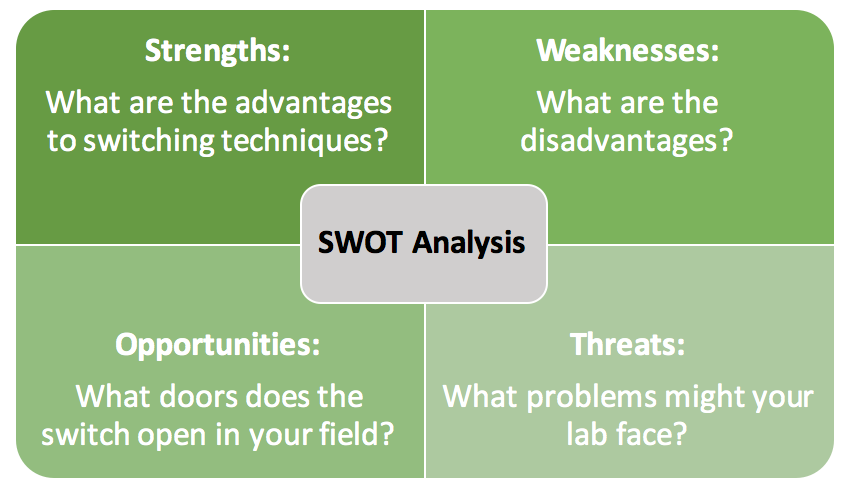When working in the life sciences, what we know is always changing. New discoveries are made, new technologies are invented, and we have to adapt. Sometimes, it can be hard to find the right way to suggest a change in the lab you’re working in, and when you do make a suggestion, you want it to be as effective as possible. Sometimes you only get one chance to convince your PI to try something different, and you want to be prepared. Take these steps to increase your chances of convincing your PI to try out something new in the lab.

Before the Pitch
When you’re going to ask your PI to try a new technique or method in the lab, you need to be as knowledgeable about the new method as possible. Do your research and find out about the new technique you’d like to implement. Find out what other options are available and carefully consider which would be the best for your lab before deciding to suggest a change.
While researching, you should identify the benefits of making a change. What is the ultimate goal and mission of your lab and how does this new method help you to better achieve such goal? Sara McCord of the Muse writes that you can start by explaining what inspired your idea from the beginning, and this can help you to align your goals with those of your supervisor. Being able to point out how your new strategy will fit with your lab’s overall goals is going to be very important during your pitch so being able to outline all of the benefits you can come up with and how they will optimize productivity and teamwork in your lab is essential. Make sure to organize your list of benefits and use concrete examples of how a change will lead to improvement.
Additionally, you will want to identify the negatives of the current method or technique your lab is using. Is it too time-consuming? Is it becoming outdated? What makes your current lab practice sub-optimal? Create a list and, once again, provide examples of when your current method may have led to less than ideal productivity.
According to an article produced by the University of Kansas, one way to evaluate the method you are proposing to your PI before making your pitch is to perform a SWOT analysis. This type of analysis seeks to identify the strengths, weaknesses, opportunities, and threats of the change you want to make. SWOT analyses are common in the business world, but can be adapted to a variety of other scenarios, including this one. This will prepare you to handle any obstacles your PI may bring up, external threats that may be relevant, as well as emphasizing the overall strengths and external opportunities your new technique may bring about.
One last preparation step you will want to employ is finding published papers in which this new method was used. If some of these are from institutions or labs similar to yours, it can be just what you need to show your PI that trying a new method and adapting to current standards is necessary to stay competitive in the research world.
ProTip: If you may not be the most influential person in your lab, and you feel that the idea might have more of a chance coming from someone else in your lab, recruit that person to help you deliver your pitch to your PI. Reputation and influence can go a long way when dealing with a PI who is not typically open to change.
|
|
||
The Pitch
When it comes time to share your idea with your PI, you should first schedule a meeting time. This will work better than randomly approaching him or her in the lab and will make it known that this is something you have actually been thinking about rather than something that just popped in your head at the time. When it comes time to meet, make sure to bring all of your organized preparation materials.
Start by explaining the change that you wish to implement. Explain it from your PI’s perspective, as well as the perspective of other team members. It can be easy to forget to evaluate the change from the perspective of your colleagues, but doing so will show your PI how much you have really considered this change. Then, explain the benefits of the change and the problems with the current method that you have previously prepared. Mention how the change will optimize achieving your goals and then show your PI the papers you found that further support the new technique you want to try. In a recent Fortune Insiders article, Liz Wiseman, president of Wiseman Group says that not being able to explain how your idea “coincides with their agent” is the worst thing that you can do during your pitch to your supervisor.
After you have thoroughly presented the idea, if your PI is open to considering your idea, explain what you will need to make it happen. Will new instruments need to be purchased? Will training be required? Make sure you inform him or her now of what materials will be necessary and how the budget will be affected.
The last thing you want to do during your pitch is plan a trial of the new technique with your PI. Come up with a date range to implement the trial run and a plan to communicate with everyone about the trial change.
ProTip: If you’re dealing with a particularly stubborn individual, sometimes strategically planning your words so that it seems almost as if your PI came up with the idea of change on his or her own, can be a great way to get through to them. Check out these life hacks on dealing with stubborn people for more ways to get through to a stubborn PI.
|
|
||
After the Pitch
After your PI agrees to have a trial of the new technique, you will want to work your best to ensure this trial run goes as smoothly as possible and that you really do your best to optimize productivity with the new method. If all goes well, you will have increased efficiency and accuracy in the lab with your new and improved procedure, and this will be useful support of keeping the change after the trial period ends.
Make sure to get support from team members during the trial run. If everyone is on the same page with your new process being superior to the previous one, it won’t be difficult to convince your PI to keep your idea in place.
ProTip: If things go wrong during the trial, make sure to find a solution to them as soon as possible. It is normal for changes to take some time to become more efficient as everyone gets used to the new procedures, so ensuring your trial run is of adequate time to emphasize the benefits of the change is essential.
Even with these tips, trying to get your PI and lab to adopt a new technique is still going to be a challenge, but now you’re better armed for the task. If you are unsuccessful, don’t stop trying. Perhaps you can conduct some internal research that will help you to convince your PI to consider switching techniques again at a later time. The key is to being successful in your venture is to be persistent without being annoying. Find a balance that allows you to bring this idea of change up enough to keep it on your PI’s mind.
Resources:
De Ternay, Guerric. “Sick of Hearing Your Boss Saying ‘No’? (10 Ways to Make Him Say ‘Yes!’).”
Contriber. (2016)
Salpeter, Miriam. “How to Persuade an Unyielding Boss to Try Something New.” U.S. News Careers. (2013)
Berkun, Scott. “How to Convince Your Boss to Try New Things.” Quality Insider. (2014)
McFarland, Scott. “How to Convince the Boss Your Idea is Incredible!” Huffington Post. (2015)
 Rebecca Talley GoldBio Staff Writer |
Rebecca is a medical student at the University of Missouri. She previously worked as a lab technician while studying biology at Truman State University. As an aspiring reproductive endocrinologist with an interest in global health, Rebecca has traveled across Central America on medical mission trips. With a passion for the life sciences, she enjoys writing for GoldBio. |
Category Code: 79108, 79109, 79102




